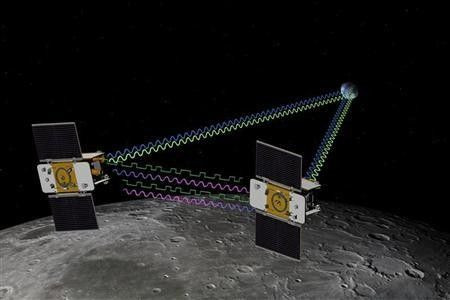Lunar Probes to Resolve Mystery of Moon's Interior

(Reuters) - Two robotic NASA probes are due to arrive at the moon this weekend to resolve a long-standing mystery of what is inside Earth's natural satellite and how it got there.
The 667-pound (303-kg) craft of the U.S. space agency's Gravity Recovery and Interior Laboratory, or GRAIL, mission have been flying to the moon since their joint launch in September.
GRAIL A is due to begin a 40-minute braking maneuver to put itself into orbit around the moon at 4:21 p.m. ET on Saturday, with GRAIL B following suit 25 hours later. Both are needed for the intricate gravity-mapping mission scheduled to begin in March.
"We won't be celebrating a lot until after we get GRAIL B into orbit late afternoon on New Year's Day," said project manager David Lehman with NASA's Jet Propulsion Laboratory in Pasadena, California.
Once in position 34 miles above the moon's surface, the GRAIL probes will fly in a line, speeding up and slowing down in response to minute gravitational tugs.
By constantly measuring changes in the distance between the two craft, scientists can create a gravity map of the moon. The changes in speed will be as subtle as a fraction of a micron per second. A micron is about the width of a red blood cell.
The data will be used to model the moon's interior, a key piece of information still missing despite more than 100 previous missions to the moon.
Scientists believe the moon formed when an object about the size of Mars smashed into Earth shortly after the formation of the solar system about 4.5 billion years ago.
"We understand little really of how this formation happened and how it cooled off after the violent event," said GRAIL lead scientist Maria Zuber with the Massachusetts Institute of Technology.
One long-standing puzzle is why the far side of the moon is so different from the side that permanently faces Earth. The near side is filled with large, dark plains formed by ancient volcanic eruptions but the far side is virtually all highlands.
"It seems that the answer is not on the surface," Zuber said. "We think the answer is locked in the interior."
Zuber and the team have 82 days to make their measurements. If the solar-powered probes, built by Lockheed Martin Corp, survive beyond the next lunar eclipse in June, the $496 million mission could be extended for a detailed mapping survey from as close as 15.5 miles above the moon's surface.
© Copyright Thomson Reuters {{Year}}. All rights reserved.





















